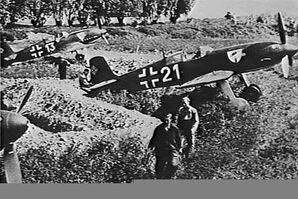The Heinkel He 100 was a German made fighter aircraft that was developed shortly before the beginning of

World War II.
History[]
After Ernst Heinkel failed with his Heinkel He 112 in the competition of the Reichsluftfahrtministerium for the new German flag-ship plane of 1935 against the Messerschmitt Bf 109, he commissioned his engineers Walter and Siegfried Günther to develop a new fighter aircraft, which should be able to reach speeds beyond 700 km/h.
At first this aircraft was called Projekt 1035, but it was later renamed to He 100.
The first flight of the He 100 V1 was on 22nd January 1938. The aircraft was powered by a Daimler-Benz DB 601 liquid-cooled inverted V12 engine. The 8th prototype, the Heinkel He 100 V8, reached on 30th March 1939, with a modified engine, on the Heinkel-Werke Oranienburg Air base a top speed of 746,61 km/h, making it the fastest aircraft of this time. The aircraft was donated to the Deutsches Museum, but because of propaganda reasons it was renamed to He 112 U.
Because of the fact that the Bf 109 was already produced in large numbers, there were no DB-601 engines for a service entry of the He 100 left, even if the He 100 was much superior to the Bf 109 in some parameters. For export, the Reichluftfahrtministerium ordered 25 aircraft (No. 3001-3025), which were called He 100 D. But after

The He 100 as a "He 113" Night-fighter
the beginning of World War II it was decided to produce only No. 3001-3016. No. 3017-3019 were only built for spare part reasons. The last He 100 D was completed in June 1940. In the year 1940 two He 100, from 21 total, were sold to Japan and ten to the USSR. The remaining aircraft were painted black and were used for air defence by Heinkel. (At least one source states these were eventually passed to Romania).
Some of the remaining aircraft were also used for propaganda, and were called He 113.